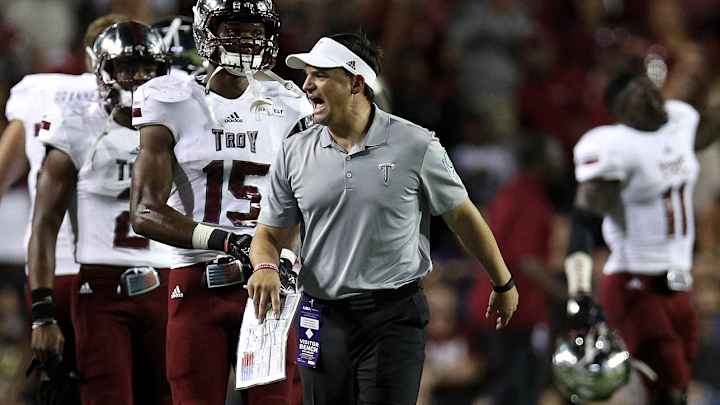Neal Brown Explains How Troy Turned to 'Big-Boy SEC Football' to Beat LSU

Week 5 was a huge one for Air Raid disciples. On Friday night, Mike Leach’s Washington State squad knocked off No. 5 USC at home to improve to 5–0 for the first time in Leach’s tenure. Then on Saturday night, Neal Brown’s Troy Trojans went to Baton Rouge as three-touchdown underdogs and upset No. 25 LSU, 24–21. If you flipped on the Troy-LSU game when you got word a big upset was going down in Death Valley, you saw an Air Raid–minded Sun Belt team running through what once had been one of the nastiest defenses in college football, gashing the Tigers for much of the night on the ground.
Wait, Troy’s an Air Raid team? After all, the Trojans only threw for 157 yards in taking down the Tigers and ran it 42 times compared to only 28 pass attempts. They grinded out the clock; there were no trick plays. Yes, Brown, a 37-year-old rising star in the coaching world, still sees himself as an Air Raid guy, but he had to tweak things to best handle LSU.
“In this game, we did nothing gimmick-wise,” Brown told SI Tuesday. “We just lined up and played big-boy SEC football.”
It wasn’t the first time Troy had gone toe-to-toe with a college football heavyweight. Last year, the Trojans gave eventual national champion Clemson all it could handle before losing 30–24, out-rushing the Tigers on the afternoon. In the past 16 years, previous Troy regimes had also given headaches to Ohio State, LSU, Tennessee, Florida State, Georgia Tech and Georgia. “We studied why those near-misses happened,” Brown says. Two key areas showed up: turnover margin and return yardage. “We were plus-two in turnover margin against LSU and we allowed zero punt return yardage. Our punter, a redshirt freshman [Tyler Sumpter], was the unsung hero."
Brown figured the Trojans’ best hope was to keep the game in the teens or low 20s, and he knew if they could drag LSU into the fourth quarter, they’d have a good shot at winning. The biggest challenge for the head coach may have been staying disciplined enough to not play with any tempo, something that usually is a staple of his offense. “I had to train myself all week,” he says, forcing himself to not start his play-calling process until there were 25 seconds left on the play clock.
Can Top-10 TCU Stay Grounded? Gary Patterson Hopes He Has the Key
Troy unveiled some schemes against LSU it hadn’t shown before. For much of the first half, Brown wanted to try and pound the Tigers, lining up in 10 personnel (one running back, no tight ends) and running the ball north and south with a heavy diet of inside zone plays. In the third quarter, Brown changed it up by running a counter play designed to look the same as the inside zone, and 235-pound bruising running back Jordan Chunn rumbled 74 yards to set up a 17–0 Troy lead. Then in the fourth quarter, Brown dressed things up with more option looks by motioning into three-back sets he knew would be tougher for the young Tigers defense to fit.
“All of our pass plays are Air Raid,” says Brown, who played receiver at Kentucky under Hal Mumme, the godfather of the offense that has spread throughout college football. “We’ve added some option elements to it.”
Those elements took root from Troy’s struggles with Willie Fritz’s option attack against Georgia Southern two years ago (Fritz is now the head coach at Tulane). Brown felt the best way to defend the option was to embrace it, installing it on offense in order to give his own defense full-speed looks in practice, and he liked what he saw. Troy offensive coordinator Kenny Edenfield also has an option background, and like most good coaches, Brown isn’t too proud to do a little borrowing. The first touchdown Troy scored against Clemson last year, a 65-yard run on fourth-and-one, came on a speed sweep play Brown took from LSU offensive coordinator Matt Canada when Canada was running the NC State offense.
In 2016, when Brown led Troy to a 10-win season in his second year at the helm, the Trojans were almost a 50-50 run-pass offense, throwing it 492 times and running the ball 485.
Brown’s playcalling and game preparation are a big reason why he was a hot name in coaching circles going into this season, but his stock is soaring now. The Trojans are 14–4 since a 4–8 finish in 2015, Brown’s debut season, and a road loss at Boise State in Week 1 was the only thing keeping them from an unbeaten September.
But Brown isn’t getting caught up in what his next coaching move may be. In the wake of the big LSU win, and all of the media attention that he and the Troy program have gotten, he’s tried to let his team enjoy what they’ve accomplished. Back in May, when he laid out his plan for the season, he’d scripted that the team take off the Sunday and Monday following the LSU game because they had a mid-week game against their arch-rival South Alabama (Wednesday, Oct. 11) up next.
“I’m a big believer in celebrate when you win,” Brown says. “This deal is so hard. They need to enjoy the good times, and this is one of those good times because I want them to understand the significance of what they accomplished.”
He has also reminded them of last year, when Troy reached the Top 25 for the first time after a big win over Appalachian State, then turned around and got whipped at home by Arkansas State, 35–3.
